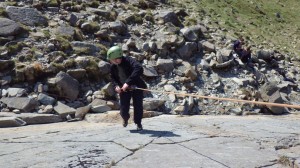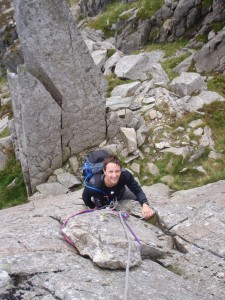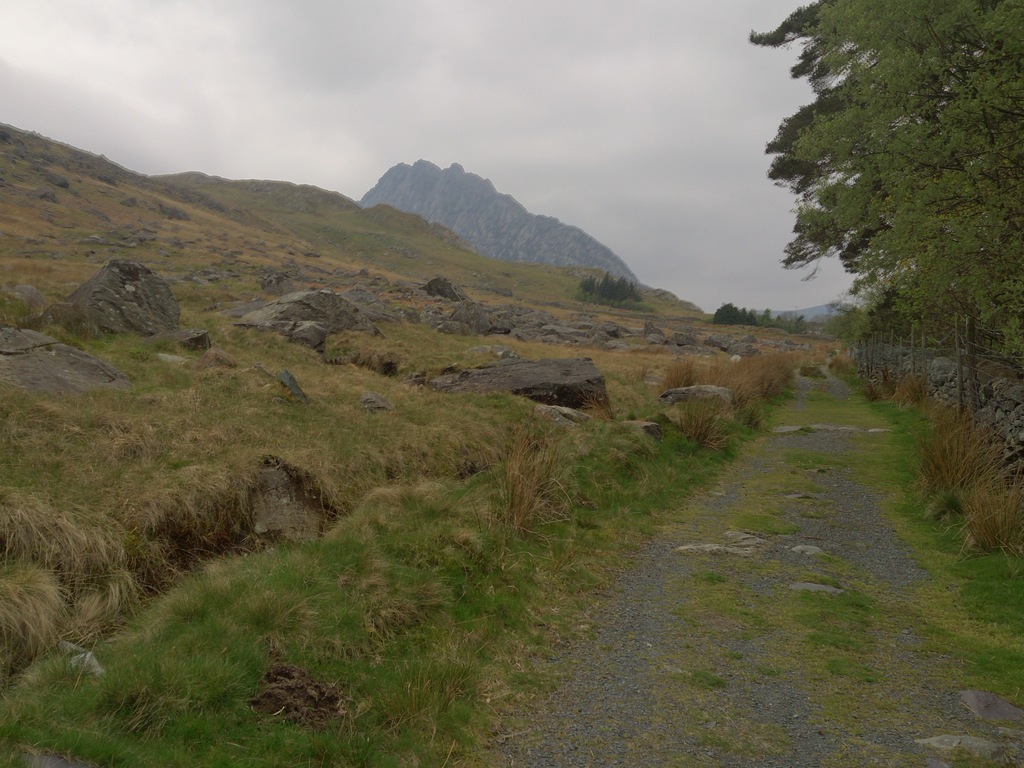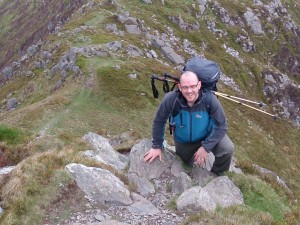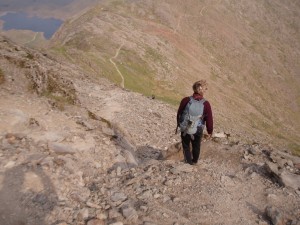scrambling
1.leading with appropriate rope systems for on multi pitch routes
2. Stance organisation. Location, preparation
3. Rope management
4. Belay systems
5. Abseiling
1. Leading with appropriate rope systems for on multi pitch routes
Double vs Single vs twin ropes for routes
2. Stance Organisation
Stance management is the general term used to describe the organisation of everybody on a stance, on multi-pitch routes. This organisation includes elements such as correct belay plate orientation, rigging of anchors; placement of leader/second on stance relative to a variety of factors e.g. hazards, belaying etc, organisation of ropes. It is perhaps the most difficult part of working on multi-pitch routes to ‘get right’, as efficient solutions tend to involve not just using the right technique(s), but adapting the relevant skills to the type of stance you are using. Many problems can be avoided if you work in a methodical manner. The main principals being:
Safety of climbers on stance
Efficient changeover at belays
Stance can accommodate everybody
Is organised such that the leader can move off with the minimum of fuss and disruption
Leader and second stacked in climbing order (e.g. leader at top/outside; second at bottom/inside)
Leader on stance at side they will move off from for next pitch
3. Rope Management
leader/second clipped in without crossing ropes
Sort ropes out so leaders rope on top of stack (back coiled)
Outside of stance clear (e.g. no axes or human runners!)
Tying into anchors (single and multiple): linking anchors with sling Vs tying into anchors
Clipping ropes and extending runners

4. Belay Systems
Appropriate belay methods, belay plate; direct belay (Italian Hitch/Plaquette).
Pros and cons of methods
Selecting a stance
Protecting the belay immediately on leaving the stance
SEMI INDIRECT
Leader tied into belay using rope
Belay plate (ATC or similar) clipped into rope loop on harness
NOTE: Position of braking hand is crucial using this method
Pros
Method is common practice.
Leader can feel the second
Can be easier to give a tight rope in extremis, or hoist
Avoids full impact force on the belay in the event of a fall. (Use of rope, and dynamic belay increases dynamic element in system)
Cons
Difficult to bring two partners up at same time if moving at different speeds. If one second weights the rope it is impossible to take in/pay out the other rope through the plate.
leader is in the system necessitating a potentially complicated escape if required
DIRECT
Italian Hitch on HMS krab clipped to attachment point (usually a single point from linked anchors)
NOTE: Requires ‘bomb proof’ anchors
Pros
Less strain on belayer
Leader not in the system
Fast method of bringing up second(s)
Two seconds can be brought up independently, simultaneously. (Rope automatically locks if loaded but allows independent operation of other rope)
Tight rope can be given
Cons
Not standard practice
Difficult to provide tight rope in extremis
Requires ‘bomb proof’ anchors
PLAQUETTE (NEW ALP ‘MAGIC PLATE)
Clipped to attachment point on main belay
Not standard practice
Very difficult/impossible to second if loaded (one-way clutch).
5. Abseiling
From rock anchors.
Backing up anchor for first person down.
Cows tail on harness for clipping into belay.
Use of friction devices.
Use of French Pruissick as ‘Dead Man’s Handle’
The Dolmen Ridge is so enjoyable in this sunny weather. Awkward to start with full on pitches and easing towards the top! But nice scrambling all the way to the top of the cliff. A great day in the shade on this long curving ridge all the way summiting on Glyder Fach. Take a look at scrambling options on http://mountaineeringjoe.co.uk/rock-scrambling-courses/
A great out scrambling on the East Face of Tryfan in the Ogwen Valley. We scrambled up Bastow Buttress and then down Nor Nor Groove and up First Principle Rib to Finish on the summit of Tryfan. Excellent day by all accounts
We discussed a lot of climbing issues such as double vs Single vs twin ropes for routes, Safety of climbers on stance. Efficient changeover at belays, stance can accommodate everybody/organised such that the leader can move off with the minimum of fuss and disruption, leader and second stacked in climbing order (e.g. leader at top/outside; second at bottom/inside), leader on stance at side they will move off from for next pitch. Leader/second clipped in without crossing ropes Sort ropes out so leaders rope on top of stack (back coiled). Tying into anchors (single and multiple): linking anchors with sling Vs tying into anchors, clipping ropes and extending runners. Belay direct and in direct. Abseiling from rock anchors, backing up anchor for first person down. Cows tail on harness for clipping into belay, the use of friction devices and the use of the French Prussic.
What a day!
This mountain skills course is all about looking after yourself in the mountains. We spent 2 days and one evening where we covered everything required to enjoy the mountains. Topics which we covered over the weekend included route planning, clothing systems, mountain weather, emergency situations, environmental issues with walking, and a whole lot of navigation in bad visibility . You also will get technical help whenever you need in the future to keep developing your mountain skills and of course a online log book to keep your walks on.
This is an ideal way to make sure you are equipped for the mountains and to have the confidence to tackle the mountain environment with the skills required!
http://mountaineeringjoe.co.uk/mountain-skills-courses-snowdonia/
Mountain skills is a 2 day 1 evening weekend course where we look at all the respects required to walk in the mountains. Handling steep ground , weather, mountain navigation, outdoor kit, emergencies and what to put in your rucksack. You will spend the weekend on some exciting mountain walks discussing all aspects of walking. You will get unlimited technical help from where to walk to the latest kit for as long as you want it so you can keep developing your skills
This is an ideal way to gain the confidence to tackle the harder routes like Crib Goch in Snowdonia
http://mountaineeringjoe.co.uk/mountain-skills-courses/
It is rocky in places, and both descend and ascend are demanding. Navigation can also be problematic in bad poor visibility conditions. You can do the walk over 2 days using a fully equipped mountain hut.
The Welsh 3000s as challenge, walk or experience is second to none! Contact me if this interests you and I can arrange something which suits you.
http://mountaineeringjoe.co.uk/mountaineering/mountain-challenges/welsh-3000s-14-peaks-challenge-in-24-hours/
Interesting links
Here are some interesting links for you! Enjoy your stay :)Pages
- About
- Anglesey Coastal Path – Guided Walks
- Booking Form
- Booking Terms and Conditions
- Climbing in Snowdonia & Anglesey, North Wales
- Contact
- Course 6: GPS Navigation: Use of a GPS for navigating
- FAQs
- Gallery
- Gift Certificates
- List of Courses & Activities
- Mountaineering
- Mountaineering Joe Page Template
- Mountaineering Skills with Mountaineering Joe
- Navigation Courses in Snowdonia
- News
- Our Use of Cookies
- Outdoor News
- Privacy Policy
- Private Guiding and Instruction
- Resources
- Rock Climbing Courses in Snowdonia
- Rock Scrambling Courses (with rope work)
- Walking in Snowdonia, Snowdon walks and ridges in North wales
- Website Terms of Use
- Welsh 3000s 14 Peaks Challenge
- Welsh 3000s Challenge Training
- Welsh 3000s: 14 Peaks Challenge in 24 Hours
- Welsh 3000s: 14 Peaks Challenge over 3 Days
- Winter Skills Courses in Scotland
- Classic Ridge Walks of Snowdonia
- COURSE 1: Intro to Hill Skills and Navigation
- COURSE 1: Intro to Scrambling
- COURSE 1: Intro to Winter Skills (week-end)
- COURSE 1: Rock Climbing for Beginners
- COURSE 2: Advanced Scrambling (with short roping techniques)
- COURSE 2: Indoor Wall to Outdoor Rock
- COURSE 2: Intro to Winter Skills (mid-week)
- COURSE 2: Navigation for fell runners
- Epic Ridge Walks of Snowdonia
- Welsh 3000s: 14 Peaks Challenge Fell Running
- COURSE 3: Advanced Navigation
- COURSE 3: Classic Scottish Mountain Ridges
- COURSE 3: Classic Snowdon Scrambles
- COURSE 3: Learning to Lead Climb
- Snowdonia Walks (week-end)
- COURSE 4: Classic Snowdon Scramble: The Snowdon Horseshoe
- COURSE 4: Contour Master Class
- COURSE 4: Discover Sea-Cliff Climbing
- Snowdonia Walks (mid-week)
- COURSE 5: Classic Snowdon Scramble: Clogwyn y Person Arête
- COURSE 5: Intro to Multi-Pitch Climbing
- COURSE 5: Intro to Winter Navigation
- Multi-day Camping trips in Snowdonia
- Rock Climbing Instructor Award (RCI) Refresher Courses in Snowdonia.
- COURSE 7: Improvised Rescue Techniques / Skills
- ML Refresher Courses in Snowdonia
- ML Refresher Courses in Snowdonia
- Hill Skills Courses in Snowdonia
- Mountain Skills Courses in Snowdonia
Categories
Archive
- February 2025
- January 2024
- October 2023
- May 2023
- March 2023
- February 2023
- January 2023
- December 2022
- August 2022
- June 2022
- August 2021
- August 2019
- July 2019
- May 2019
- April 2019
- February 2019
- November 2018
- October 2018
- September 2018
- August 2018
- May 2018
- April 2018
- March 2018
- February 2018
- December 2017
- November 2017
- August 2017
- July 2017
- May 2017
- March 2017
- February 2017
- January 2017
- December 2016
- November 2016
- October 2016
- September 2016
- August 2016
- July 2016
- June 2016
- May 2016
- April 2016
- March 2016
- February 2016
- January 2016
- November 2015
- October 2015
- September 2015
- August 2015
- July 2015
- June 2015
- May 2015
- April 2015
- March 2015
- February 2015
- January 2015
- December 2014
- November 2014
- October 2014
- September 2014
- August 2014
- July 2014
- June 2014
- May 2014
- April 2014
- March 2014
- February 2014
- January 2014
- December 2013
- November 2013
- October 2013
- September 2013
- August 2013
- July 2013
- June 2013
- May 2013
- April 2013
- March 2013
- February 2013
- January 2013
- December 2012
- November 2012
- August 2012
- July 2012
- June 2012






